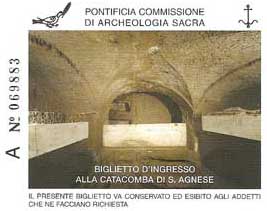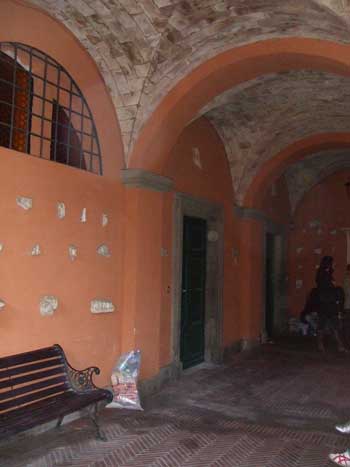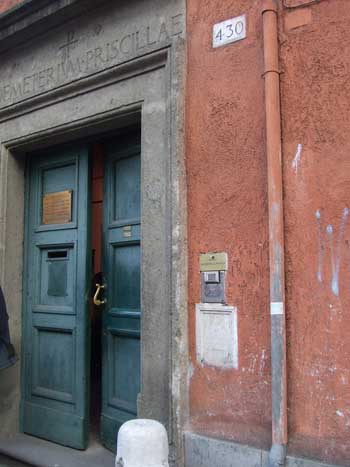The catacombs of Rome are underground burial complexes outside the ancient city walls. They are popular tourist destinations, and are visited on brief guided tours.

In ancient Rome burials weren’t permitted within the city walls, so tombs and funerary monuments were placed alongside the roads leading into town, outside the gates. For those who couldn’t afford grand tombs, communal graves in catacombs made a practical alternative. Romans favoured cremation, so it tended to be particular religious groups, with their own beliefs about the afterlife, who buried their dead in catacombs. The Christian catacombs of Rome are famous, but there were also catacombs used by other groups such as the Jews. There are other catacombs in Italy, too, including some in Siracusa, in Sicily.
Catacombs are underground tunnel systems, dug out of the soft volcanic rock (tufo in Italian, tuff in English) of the Roman countryside. Each tunnel is lined with niches where bodies were placed, wrapped in linen shrouds with some lime to aid decomposition, then sealed with carved marble slabs (for those who could afford it) or brick. As demand grew, the catacombs could be extended outwards or down further into the earth. Some extend downwards for five levels and include miles of tunnel.

Popular myth portrays the catacombs as tunnels where persecuted Christians would hide, but this is far from the truth, as all the Rome tour guides will take pains to explain. They were simply used for burials, and perhaps for religious ceremonies associated with burial and remembering the dead. The catacombs were mostly in use from the 2nd century, when Christians were still subject to persecution and had problems acquiring land for burials, but they continued to be used afterwards, up until the fifth century. Later, many of the bones of martyrs and saints were removed and distributed among churches for safekeeping and worship, while the catacombs became lost to memory. They began to be rediscovered and explored in the sixteenth century, and now they are tourist attractions, although mostly run by religious foundations. They are overseen by the Vatican’s Pontifical Commission for Sacred Archaeology, which has a webpage featuring up-to-date opening times (see links panel on the right), admission prices, bus routes and a decent overview of the Christian catacombs both in Rome and elsewhere.
Visiting the catacombs
There are five sets of catacombs (catacombe in Italian) in Rome which are open regularly to the public. They are all very similar, and the visiting experience is pretty much the same whichever you choose. On arrival you purchase a ticket, await a guided tour in your language of choice, and are then ushered rapidly around a small section of the catacomb for about twenty minutes, while the guide rattles off a fairly mechanical commentary along with a few jokes about getting lost. In each you will see only a small proportion of the tunnel complex, but enough to give you an idea of how these places were used. You’ll see grave-niches which have been emptied and some which are still sealed. Fragments of marble inscriptions in Greek and Latin and engravings of early Christian symbols such as the fish are displayed on the walls. It’s an interesting experience, particularly if you are interested in the history of Christianity, but some people do find the tours – and the debunking of myths – an anti-climax.
Since you have to travel outside the centre of Rome to see any of the public catacombs, I’d recommend combining the excursion with another attraction. The catacombs along the Via Appia Antica (San Sebastiano and San Callisto) are the most visited by tour parties, but they are also convenient for seeing the rest of this outstanding archaeological area. You could spend a half-day or more visiting the Catacombs of San Sebastiano, walking along the ancient Appian Way, visiting its monuments and discovering the little-known countryside archaeological park of the Caffarella. Alternatively the catacombs of Sant’Agnese and of Priscilla are slightly more atmospheric and a shorter journey from the heart of town; Sant’Agnese is part of an interesting historical site.
Below is a brief description of the various sets of catacombs open to the public. It’s a good idea to check the latest opening times before travelling, as opening hours are limited, and you could end up wasting time waiting for the catacombs to open after lunch. The tours are in narrow dark corridors, with uneven rough earth flooring and steps to negotiate.
San Sebastiano
The Catacombe di San Sebastiano (St. Sebastian) are conveniently-located on the Via Appia Antica (Appian Way) close to a picturesque stretch of the road with other interesting sights, so they fit well into a day or half-day exploring this interesting area. These catacombs are the only ones which weren’t ‘lost’ over the centuries and the word ‘catacomb’ derives from their location in an old stone quarry. As well as the usual tour of underground passageways and grave-niches you can also visit the church above, the Basilica di San Sebastiano. This tour includes something a bit different: three pagan Roman tombs decorated with frescoes and architectural embellishments.
Closed Sundays and from 15th November to 15 December. Open 9-12 and 2-5. Buses: 218 from San Giovanni, 118 from Piramide or 660 from Colli Albani.
San Callisto
The Catacombe di San Callisto (St. Calixtus), just off the Via Appia Antica, are very extensive. There are five underground levels (though you won’t see them all on a tour) and many miles of tomb-lined galleries. Some early popes were interred here, and the tour also visits the spot where St. Cecilia’s body is said to have been found before being removed to the church dedicated to her in Trastevere. There are some early frescoes of Biblical stories. This is very busy, commercially-run and is probably the most conveyor-belt-like of Rome’s catacombs. Don’t expect too much atmosphere from the tour, although the setting in a countryside park area off the Appia Antica is quite picturesque. You receive a talk (choose from a wide range of languages) before entering the catacombs, then zoom around with the guide. This set of catacombs is popular with large tour groups, since there is parking for coaches.
Closed Wednesdays and in February. Opening times 9-12; 2-5. Buses: 218 from San Giovanni or 118 from Piramide.
Sant’Agnese
In Sant’Agnese the tour of the catacombs is brief, but you do see a couple of niches containing crumbling skeletons before finishing the tour by the crypt containing St. Agnes’s tomb (her body lies here; her head in the church dedicated to her in Piazza Navona, the scene of her martyrdom). When I visited this was the most atmospheric tour, with the smallest number of visitors. This is a whole early Christian complex, with the historic church of Sant’Agnese fuori le Mura (‘outside the city walls’), ruins of a large fourth-century basilica and the round mausoleum built by Constantina, the daughter of the Emperor Constantine for herself and her sister Helena (known as the Church of Santa Costanza). If you come here to see the catacombs, you await the guide just inside the entrance to the main church of Sant’Agnese – a sign on the door announces the next tour time. You shouldn’t miss the other buildings here, particularly the mausoleum with its lovely fourth-century mosaics.
The catacombs are located to the north-east of central Rome, in a large and anonymous stretch of residential and commercial expansion. Location: Via Nomentana 349, served by the 60 express bus from the Colosseum, Piazza Venezia and Via Nazionale, the 90 and 36 from Stazione Termini and the 84 from Piazza Venezia. Closed in November, on Sundays and on the mornings of public holidays. Opening hours: 9-12 and 4-6. Admission to the catacombs €6 (the church buildings are free to enter).

Catacombe di Priscilla
In the Catacombe di Priscilla, below a Benedictine convent, there are some rare frescoes preserved, including one which is claimed to be one of the earliest representations of the Madonna and Child. You can also peer into a shaft used for illumination and fresh air. In what was once part of the Roman villa belonging to Priscilla, who presented this land to the Christians, there is a tomb chamber containing some pretty wall-paintings of Christian scenes. Guidebooks tend to recommend these catacombs as being atmospheric – so perhaps that is why they seemed so popular when I visited. Coinciding with massive schoolparty-tours, my group seemed to be forever dodging gangs of Italian teenagers in the underground spaces.
Location: The catacombs are at Via Salaria, 430. The entrance is a secretive doorway on the main road facing the walls of the park of Villa Ada, which makes a good spot to rest or picnic on a sunny day. Closed on Mondays and in August. Open 8:30-12 and 2:30-5 (check the latest times and prices online). Buses: 86, 92 and 310 from Stazione Termini; 63 from Piazza Venezia / Largo Argentina / Barberini.
Domitilla
The Catacombe di Domitilla are situated on Via delle Sette Chiese, between the Via Appia Antica and the major modern highway, the Via Cristoforo Colombo. The attractive early Christian basilica here is dedicated to two Christian martyrs, Nereo and Achilleo (St. Nereus and St. Achilleus), who were buried here. Other highlights of the tour include some 2nd century frescoes.
Closed Tuesdays and in January. Open 9-12 and 2-5. The buses which pass nearest to the catacombs are the 218 from San Giovanni and the 716 from Via Teatro Marcello.
Other catacombs
Rome’s other catacombs are not opened regularly. Responsibility for the Christian catacombs rests with the Vatican’s Pontifical Commission for Sacred Archaeology (Pontificia Commissione di Archeologia Sacra), to whom you should apply for admission to the catacombs which are closed to the public (see links panel). There are Jewish catacombs at Vigna Randanini close to San Sebastiano which may be visitable by prior arrangement, and others (closed to visitors) at the Villa Torlonia on Via Nomentana. The website of the International Catacomb Society (see links) provides copious information about many of the catacombs – some of the practical information is out of date but it gives an overview of the different catacombs.
On this site
Caffarella archaeological park
Official websites of the catacombs
San Callisto, and general information
More external links